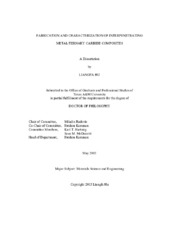| dc.description.abstract | Advances in various aerospace and energy technologies call for new, multifunctional materials capable of operating under conditions that are challenging to the most advanced high-temperature metallic alloys. Composites that combine attributes of both the ceramics and metals, specifically metal/ternary carbide composites, hold the greatest promise to provide such multi-functionalities. These composites have not been made because of fabrication limitations. Further explorations of their multi-functionalities are necessary. The present work concerns such composites, develops two fabrication methods (i.e. infiltration and powder metallurgy), and explores multi-functionalities of the newly developed composites.
The prospect of extending fabrication methods to develop new, highly reactive metal/ternary carbide composites is examined in the present work. Controlled microstructures in metal/ternary carbide composites were obtained using the carbide foams with controlled pore structures and metal infiltration. The resulting composites were lightweight and displayed exceptional mechanical properties at both ambient and elevated temperatures. Aluminum alloy 6061 (AA6061)/Ti2AlC composites with different alloy contents and metallic phase sizes were processed and characterized. These structures achieved a compressive strength that is 3.5 times higher than the yield strength of peak-aged AA6061 at room temperature and 14 times higher at 400 °C. Strengthening mechanisms are described together with further strengthening strategies.
Spark plasma sintering (SPS) —a rapid sintering technique — was used to fabricate shape memory alloy/ternary carbide composites. Conventional methods are challenged to fabricate such composites because of severe and detrimental reactions. NiTi/Ti2AlC and NiTi/Ti3SiC2 powder mixtures were processed in the 960–1100 °C temperature range under 100–300 MPa for 3–30 minutes. Phase transformation behavior of the composites was studied using differential scanning calorimetry and was compared with starting powders to evaluate the transformable NiTi in the composites. We studied the effects of starting materials and processing conditions (sintering temperature, soaking time, and sintering pressure) on densification, reaction, and transformation behavior. A high-pressure run produced a fully-dense NiTi/Ti3SiC2 composite with a maximum percent of transformable NiTi. We developed reaction mechanisms based on phase analysis of the interfacial reaction layers. It is clearly shown that SPS is a viable technique to fabricate highly reactive ceramic-metal systems with active components. | en |


